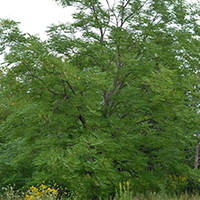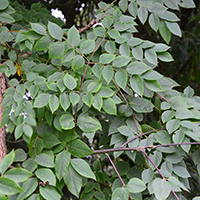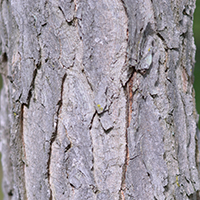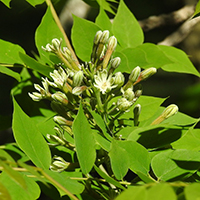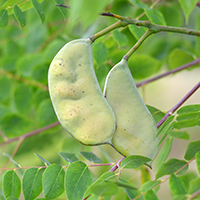What Kentucky coffeetree looks like
Size and shape
- Reaches 25 metres high.
- Trunk up to 1 metre in diameter.
Leaves
- Dark green.
- Doubly compound leaves, with secondary leaflets also compound.
- Leaflet edges are smooth and central stalk is often mistaken for a stem.
Bark
- Dark grey with scaly ridges that curl outwards.
Flowers
- Greenish-white.
- Grow as clusters at the end of branches.
- Bloom in spring when leaves appear.
Fruit
- Pods covered in a dark, hard, leathery husk (12 to 20 centimetres) hanging from a stalk (2 to 3 centimetres).
- Remain on tree throughout winter.
Where Kentucky coffeetree is found
Kentucky coffeetree only grows naturally in Southwestern Ontario but is planted throughout Southern Ontario.
What you need to know to grow Kentucky coffeetree
- Moisture: grows best in well-drained soils and is drought tolerant.
- Soil: grows in many soil types, including acidic, alkaline, loamy, sandy and clay soils.
- Shade: grows best in full sun.
- Note: Kentucky coffeetree is a species at risk in Ontario.
Find out what we are doing to protect Kentucky coffeetree by reading the recovery strategy.
Benefits and uses of Kentucky coffeetree
Wildlife benefits
Kentucky coffeetree provides nesting sites for birds. The seeds are toxic so do not benefit wildlife.
Commercial uses
Kentucky coffeetree is commonly planted as a shade and ornamental tree. The wood has also been used to produce:
- furniture
- cabinetry
- fence posts
- utility wood
Fun facts about Kentucky coffeetree
- Kentucky coffeetree pods and seeds were adapted to being eaten by extinct megafauna such as giant sloths. Since modern mammals do not eat and disperse them, Kentucky coffeetrees are not as widespread as they once were.
- It has the largest leaves of any native tree species in Canada.
- It got its name because early settlers in Kentucky would use the roasted seeds to make a coffee substitute.
Updated: January 10, 2024
Published: July 18, 2014
